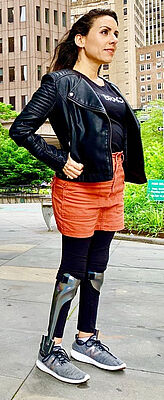What is Charcot-Marie-Tooth Disease (CMT)?

Charcot-Marie-Tooth (CMT) is a hereditary disorder that mainly affects peripheral nerves and individual spinal cord segments. The name is derived from the names of the researchers Jean-Martin Charcot (1825-1893), Pierre Marie (1853-1940) and Howard Tooth (1856-1926). It is also commonly referred to as hereditary motor sensory neuropathy type I (HMSN I). CMT belongs to the neuromuscular diseases.
Charcot-Marie-Tooth disease affects around 20-30 out of every 100,000 people, making it one of the most common neurogenetic disorders. In CMT, the transmission of nerve impulses in the peripheral nerves is impaired. As a result, the impulses from the brain are not or not correctly directed to the muscles. This denervation leads to the weakening of the affected muscles, which results in muscle atrophy. The disease often develops in childhood, sometimes only becoming noticeable between the ages of 20 and 30. The primary symptom is pronounced weakness of the hands and feet, which gradually progresses to the arms and legs.
Why an Orthosis Helps with CMT
In CMT, treatment with one or two orthoses is usually recommended, as the dorsiflexion-assist muscles, more specifically the m. tibialis anterior, which runs from the tibia to the medial edge of the foot, are affected first by CMT. This muscle, which belongs to the group of dorsiflexors, lifts the foot by concentric muscle work on the one hand, and lowers the forefoot in a controlled manner by eccentric muscle work on the other. A weakness of the m. tibialis anterior causes an unsteady gait. As the foot hangs flaccidly in swing phase, the patient has to lift the leg using the thigh or hip until the toes lift off the ground to prevent stumbling. The foot then touches the floor with the forefoot instead of the heel or the heel lands during initial contact in such a way that the forefoot drops to the ground without slowing down.
In Charcot-Marie-Tooth disease, the production of a custom-made orthosis is especially useful. Depending on which muscle groups are affected, an orthosis can be individually planned with the appropriate orthotic functions. The orthotic joints with the corresponding functional elements are usually mounted onto an ankle-foot orthosis (AFO) for CMT patients. The focus is on the functional elements for foot lifting and adjustable control of lowering the forefoot. In addition to these functions, the functional elements of the orthosis stabilise the ankle and provide the patient with an improved sense of balance during stance and gait, without limiting the mobility and dynamics of the ankle joint. It is of great advantage if the resistance of the functional elements for the directions of movement dorsiflexion and plantar flexion can be adjusted separately, which is why a system joint from the NEURO SWING group is often used to produce a custom-made orthosis for Charcot-Marie-Tooth.
You will find an overview of the different system joints in the knee and ankle area here. The most important functions of the respective system joint are explained in the corresponding product description.
In our user stories and videos, you can get to know patients who have already been treated with an orthosis. You can find the section on patients with Charcot-Marie-Tooth disease here.